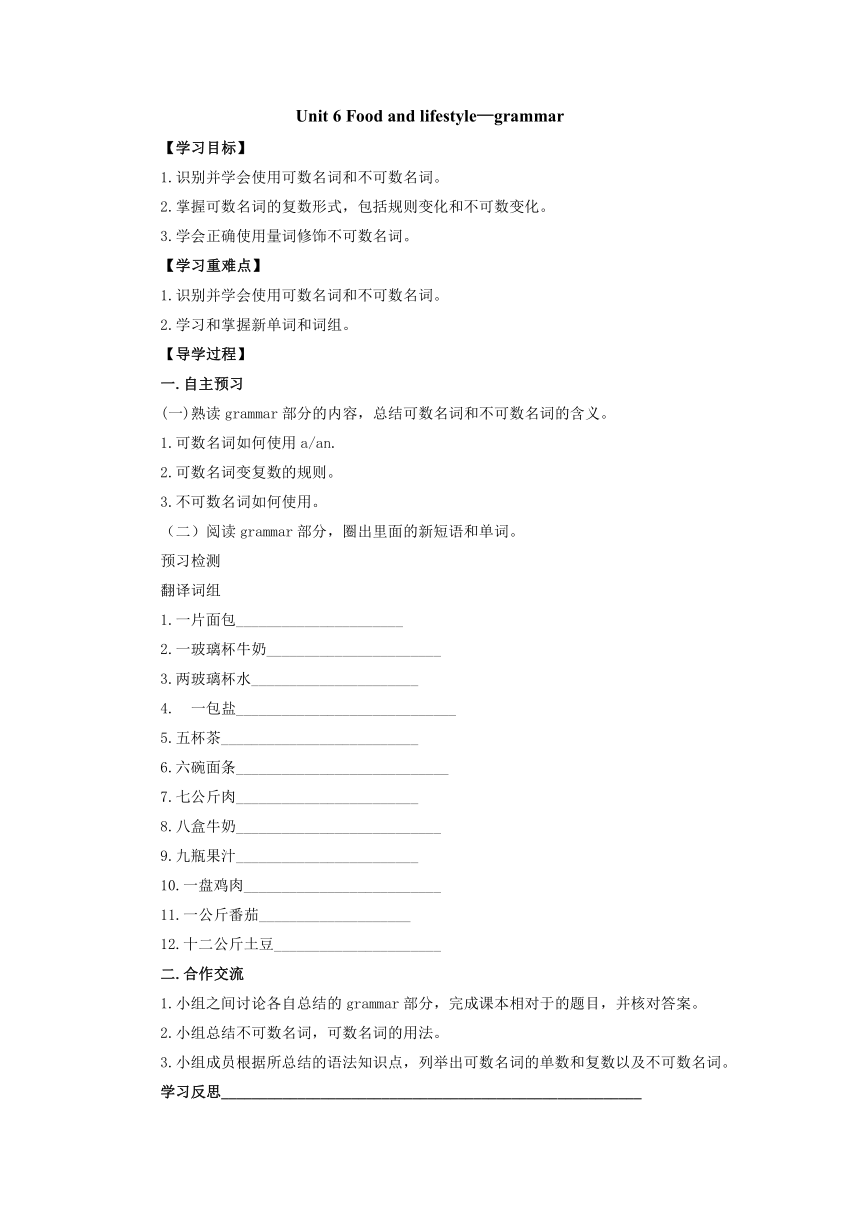Unit 6 Food and lifestyle-grammar导学案(含答案)译林牛津版七年级英语上册
文档属性
| 名称 | Unit 6 Food and lifestyle-grammar导学案(含答案)译林牛津版七年级英语上册 |

|
|
| 格式 | doc | ||
| 文件大小 | 23.0KB | ||
| 资源类型 | 教案 | ||
| 版本资源 | 牛津译林版 | ||
| 科目 | 英语 | ||
| 更新时间 | 2023-08-07 11:36:09 | ||
图片预览

文档简介
Unit 6 Food and lifestyle—grammar
【学习目标】
1.识别并学会使用可数名词和不可数名词。
2.掌握可数名词的复数形式,包括规则变化和不可数变化。
3.学会正确使用量词修饰不可数名词。
【学习重难点】
1.识别并学会使用可数名词和不可数名词。
2.学习和掌握新单词和词组。
【导学过程】
一.自主预习
(一)熟读grammar部分的内容,总结可数名词和不可数名词的含义。
1.可数名词如何使用a/an.
2.可数名词变复数的规则。
3.不可数名词如何使用。
(二)阅读grammar部分,圈出里面的新短语和单词。
预习检测
翻译词组
1.一片面包______________________
2.一玻璃杯牛奶_______________________
3.两玻璃杯水______________________
4. 一包盐_____________________________
5.五杯茶__________________________
6.六碗面条____________________________
7.七公斤肉________________________
8.八盒牛奶___________________________
9.九瓶果汁________________________
10.一盘鸡肉__________________________
11.一公斤番茄____________________
12.十二公斤土豆______________________
二.合作交流
1.小组之间讨论各自总结的grammar部分,完成课本相对于的题目,并核对答案。
2.小组总结不可数名词,可数名词的用法。
3.小组成员根据所总结的语法知识点,列举出可数名词的单数和复数以及不可数名词。
学习反思_______________________________________________________
课堂检测
一.写出下列名词的复数形式
1. boy _________ 2. story ________ 3. watch ________
4. wish _________ 5. fox __________ 6. radio _________
7. tomato _______ 8. knife _________ 9. shelf _________
10. foot _________ 11. woman ________ 12. child ________
13. tooth _______ 14. sheep _______
二. 根据句子意思,用括号中所给词的正确形式填空
1. There are so many ____ (sheep) on the hill.
2. He likes eating ________ (tomato) with eggs.
3. ________ (knife) are usually used to cut things.
4. The twins want to be _________ (dance) when they grow up.
5. We should have a lot of __________ (蔬菜) for three meals every day.
6. _______________ (糖果) are bad for your teeth.
7. There are some ________ (胡萝卜) on the table.
8. He spends two _______ (小时) on his homework every day.
9. We have three ______ (餐,饭) each day.
参考答案
一. 1.boys 2.stories 3.watches 4.wishes 5.foxes 6.radios 7.tomatoes 8.knives 9.shelves 10.feet 11.women 12.children 13.teeth 14.sheep
二. 1.sheep 2.tomatoes 3.Knives 4.dancers 5.vegetables 6.Sweets 7.carrots 8.hours 9.meals
PAGE
【学习目标】
1.识别并学会使用可数名词和不可数名词。
2.掌握可数名词的复数形式,包括规则变化和不可数变化。
3.学会正确使用量词修饰不可数名词。
【学习重难点】
1.识别并学会使用可数名词和不可数名词。
2.学习和掌握新单词和词组。
【导学过程】
一.自主预习
(一)熟读grammar部分的内容,总结可数名词和不可数名词的含义。
1.可数名词如何使用a/an.
2.可数名词变复数的规则。
3.不可数名词如何使用。
(二)阅读grammar部分,圈出里面的新短语和单词。
预习检测
翻译词组
1.一片面包______________________
2.一玻璃杯牛奶_______________________
3.两玻璃杯水______________________
4. 一包盐_____________________________
5.五杯茶__________________________
6.六碗面条____________________________
7.七公斤肉________________________
8.八盒牛奶___________________________
9.九瓶果汁________________________
10.一盘鸡肉__________________________
11.一公斤番茄____________________
12.十二公斤土豆______________________
二.合作交流
1.小组之间讨论各自总结的grammar部分,完成课本相对于的题目,并核对答案。
2.小组总结不可数名词,可数名词的用法。
3.小组成员根据所总结的语法知识点,列举出可数名词的单数和复数以及不可数名词。
学习反思_______________________________________________________
课堂检测
一.写出下列名词的复数形式
1. boy _________ 2. story ________ 3. watch ________
4. wish _________ 5. fox __________ 6. radio _________
7. tomato _______ 8. knife _________ 9. shelf _________
10. foot _________ 11. woman ________ 12. child ________
13. tooth _______ 14. sheep _______
二. 根据句子意思,用括号中所给词的正确形式填空
1. There are so many ____ (sheep) on the hill.
2. He likes eating ________ (tomato) with eggs.
3. ________ (knife) are usually used to cut things.
4. The twins want to be _________ (dance) when they grow up.
5. We should have a lot of __________ (蔬菜) for three meals every day.
6. _______________ (糖果) are bad for your teeth.
7. There are some ________ (胡萝卜) on the table.
8. He spends two _______ (小时) on his homework every day.
9. We have three ______ (餐,饭) each day.
参考答案
一. 1.boys 2.stories 3.watches 4.wishes 5.foxes 6.radios 7.tomatoes 8.knives 9.shelves 10.feet 11.women 12.children 13.teeth 14.sheep
二. 1.sheep 2.tomatoes 3.Knives 4.dancers 5.vegetables 6.Sweets 7.carrots 8.hours 9.meals
PAGE
同课章节目录
- 预备课程
- Lesson 1 Nice to meet you !
- Lesson 2 A happy family
- Lesson 3 A nice school
- Lesson 4 You look cool !
- Lesson 5 Wonderful things
- Lesson 6 Have nice food
- Lesson 7 Enjoy our days
- Lesson 8 Let's have fun !
- Unit 1 This is me
- Unit 2 Let's play sports
- Unit 3 Welcome to our school
- Unit 4 My day
- Unit 5 Let’s celebrate
- Unit 6 Food and lifestyle
- Unit 7 Shopping
- Unit 8 Fashion
